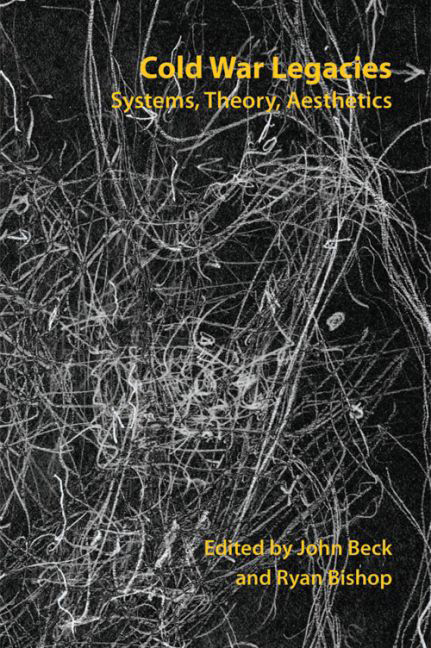Book contents
- Frontmatter
- Contents
- List of Figures
- Series Editors’ Preface
- Acknowledgements
- Notes on Contributors
- Introduction: The Long Cold War
- I PATTERN RECOGNITION
- 1 The Future: RAND, Brand and Dangerous to Know
- 2 Simulate, Optimise, Partition: Algorithmic Diagrams of Pattern Recognition from 1953 Onwards
- 3 Impulsive Synchronisation: A Conversation on Military Technologies and Audiovisual Arts
- II THE PERSISTENCE OF THE NUCLEAR
- III UBIQUITOUS SURVEILLANCE
- IV PERVASIVE MEDIATIONS
- Index
2 - Simulate, Optimise, Partition: Algorithmic Diagrams of Pattern Recognition from 1953 Onwards
from I - PATTERN RECOGNITION
Published online by Cambridge University Press: 10 May 2017
- Frontmatter
- Contents
- List of Figures
- Series Editors’ Preface
- Acknowledgements
- Notes on Contributors
- Introduction: The Long Cold War
- I PATTERN RECOGNITION
- 1 The Future: RAND, Brand and Dangerous to Know
- 2 Simulate, Optimise, Partition: Algorithmic Diagrams of Pattern Recognition from 1953 Onwards
- 3 Impulsive Synchronisation: A Conversation on Military Technologies and Audiovisual Arts
- II THE PERSISTENCE OF THE NUCLEAR
- III UBIQUITOUS SURVEILLANCE
- IV PERVASIVE MEDIATIONS
- Index
Summary
Contemporary attempts to find patterns in data, ranging from the now mundane technologies of touchscreen gesture recognition through to mammoth infrastructure-heavy practices of deep learning conducted by major business, scientific and government actors to find cats (Markoff 2012), the Higgs boson, credit card fraud or terrorists, rely on a group of algorithms intensively developed during the 1950–1960s in physics, engineering and psychology. Whether we designate them as pattern recognition, data mining or machine learning (all terms that first came into play during the 1950s), the standard account enunciated by proponents (and opponents) of these techniques is that they uncover patterns in data that cannot appear directly to the human eye, either because there are too many items for anyone to look at, or because the patterns are too subtly woven through in the data.
In the contemporary narratives of their efficacy and indeed necessity, the spectrum of differences accommodated under the rubric of pattern is striking. Pattern here is understood to encompass language, images, measurements and traces of many different kinds. Pattern finding techniques – although that term is problematic because it suggests skilled hands doing something; I will refer to them as operations– diagram a strikingly new kind of continuum or field which accommodates seemingly very different things – terrorists, fundamental particles, photographs, market transactions, utterances and gestures – more or less uniformly.
What counts as pattern finding today, I will suggest, can be better understood by taking into account the transformations in simulating, optimising and above all classifyingassociated with different uses of computers taking shape in the mid-twentieth century. Despite their often somewhat ahistorical invocations, the patterns recognised in pattern recognition have a historically concrete specificity. From the plethora of operations in current use, three diagrams developed in the Cold War era operate in contemporary modes of pattern finding:
1. Monte Carlo simulation as a way of shaping fl ows of random numbers to explore irregular probability distributions;
2. convex optimisationsor finding maximum- or minimum-value numerical solutions to systems of equations as a way of classifying things;
3. recursive partitioningalgorithms that reorder differences according to clustering and sparsity in data.
The operations expressed in these diagrams took shape in different places – nuclear physics, control systems engineering and psychology – but soon moved across boundaries between academic disciplines, and between domains such as universities, industry, the military and government.
Information
- Type
- Chapter
- Information
- Cold War LegaciesLegacy, Theory, Aesthetics, pp. 50 - 69Publisher: Edinburgh University PressPrint publication year: 2016
